
Little Black Crow
کتاب های مرتبط
- اطلاعات
- نقد و بررسی
- دیدگاه کاربران
نقد و بررسی

August 23, 2010
Surrounded by blurry blue watercolor skies and wheat-brown daubs suggestive of autumn fields, a boy sits on a rail fence and talks to a small crow. At first, his rhyming questions seem simple: "Little black crow, where do you go?/ Where do you go in the cold white snow?" As the queries continue, readers may begin to consider the mysterious outdoor lives of animals and the things humans take for granted. The boy asks, "Is it enough to have feathers in all kinds of weathers?" as blue and brown slashes of rain whip around the crow. The crow, inked with an enormous beak and a comparatively tiny body, seems to grin but offers no reply. The boy also wonders about the crow's family ("Are you a boy like me?") and asks whether the crow might love "the little gray dove" perched next to him on a power line. Caldecott Medalist Raschka (The Hello Goodbye Window) leaves the questions unanswered and pictures the curious crow landing next to the boy at the close of this thought-provoking, nature-centered reflection. Ages 4–7.

Starred review from July 15, 2010
Reminiscent of Christopher Myers's Black Cat (1999), but set in a rural rather than an urban setting, a lyrical text muses about the daily life of the titular little black crow. "Little black crow, / where do you go? // Where do you go / in the cold white snow?" opens the text, which then follows the crow through many different scenes. Framed by title-page and final-page illustrations of a boy sitting on a post-and-rail fence, the rest of the illustrations focus on the crow in different settings and interacting with various creatures; at one point the boy looks up at the crow from a distance and asks, "Little black crow / in that tall tree, / are you a boy like me?" Raschka demonstrates his Caldecott-winning mastery with controlled use of color, ample white space and expressive lines that suggest setting and deftly provide characterization with the slightest of brushstrokes. With palette, composition and mood evocative of the Japanese masters, the fluid watercolors establish a serene background for the inky crow. This quiet book that positions the child as a curious observer of the natural world is a little picture-book gem. (Picture book. 4-8)
(COPYRIGHT (2010) KIRKUS REVIEWS/NIELSEN BUSINESS MEDIA, INC. ALL RIGHTS RESERVED.)

Starred review from July 1, 2010
PreS-Gr 3—-llustrations and text work as one as a boy spies a bird and begins to ask questions. "Little black crow, /where do you go?/Where do you go/in the cold white snow?/Where do you go?" The initially fact-based inquiries progress from solid to more ethereal. "Little black crow/in the white snow, /in the blue sky, /in the brown below, /do you ever wonder/about stars you see?/Might you ever wonder/about someone.../...like me?" Impressionistic watercolor landscapes perfectly set the mood and style for these awe-filled inquiries of a curious child. Spare brushstrokes leave large areas of white, and, much like the unanswered inquiries, encourage readers to suggest answers and ask more questions; the minimalist paintings create an opportunity to imagine more. Enjoy this beautiful book with a group or share it quietly with a single child.—"Carolyn Janssen, Public Library of Cincinnati and Hamilton County, OH"
Copyright 2010 School Library Journal, LLC Used with permission.

June 1, 2010
Grades K-2 As a young boy observes a bird fly through skies that alternate from stormy to sunny, cold to warm, he wonders, Little black crow, where do you go? This query is followed by more rhetorical statements that get right to the heart of childrens own questions about family, friends, love, fear, mistakes, and, above all, self-worth. Raschka uses thick, black, ink lines in abstract depictions of the boy, who appears only at the beginning, middle, and end of the book, and of the seemingly carefree bird with an oversize beak that is featured on each of the double-page spreads, along with a few short lines of gentle, rhyming text. The lonely, rural, outdoor settings are washed across wide, white pages in watercolors of browns, blues, pinks, and yellows. With its satisfying closure, this quiet, tender book will appeal to contemplative young kids who wonder about their place in the world and whether other creatures, crow and child alike, share similar, powerful feelings.(Reprinted with permission of Booklist, copyright 2010, American Library Association.)

























دیدگاه کاربران